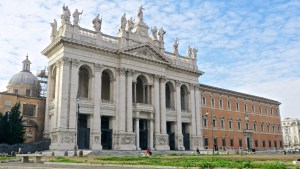Lenten Campaign 2025
This content is free of charge, as are all our articles.
Support us with a donation that is tax-deductible and enable us to continue to reach millions of readers.
Archaeologists in Rome have made a remarkable discovery beneath the renowned Piazza San Giovanni in Laterano, uncovering a series of medieval structures that may have served as a papal residence between the 9th and 13th centuries. This discovery offers new insights into Rome’s medieval history – a period often overshadowed by the city’s ancient and Renaissance past.
Medievalists.net explains that the excavation, led by the Special Superintendency of Rome under the direction of Daniela Porro, marks the first extensive archaeological investigation in this historically rich square. Located right next to the Papal Archbasilica of St. John Lateran, the most ancient and important basilica in the West, the structures uncovered provide a fascinating insight into the architecture of the period.
Wall for defense
The discovered remains include a defensive wall that is believed to have protected the papal residence during a turbulent era in Rome’s history. As read in Medievalists.net, this period was marked by frequent Muslim raids and intense internal conflicts among the city’s aristocratic families, who vied for control of the papacy and its influence.
The construction of the wall, which dates back to the 9th century, consists of large blocks of tuff stone, reused from older buildings. The structure shows evidence of restorations up to the 13th century, reflecting the continuing need for defense and fortification.
This discovery is particularly significant because it sheds light on a lesser-known chapter of Rome’s history. The Middle Ages, though marked by instability and conflict, also saw the rise of the papacy as a central power in Europe. However, when the papacy moved to Avignon in 1305, the once important defensive structures and the adjacent palace fell into disuse and were eventually dismantled.
Gennaro Sangiuliano, Italy’s Minister of Culture, emphasized the importance of the discovery: “The new finds […] are further proof of the richness of the territory of Rome, an inexhaustible mine of archaeological treasures. Every single stone speaks to us and tells its story.”
Sangiuliano praised the dedication of the archaeologists, highlighting the delicate balance between preserving Rome’s ancient heritage and the modern needs of the city.
This discovery deepens our understanding of medieval Rome, of the papacy, and of its influence on the city’s history. As archaeologists continue their work, more secrets of this pivotal era may yet emerge from beneath the busy streets of Rome.



